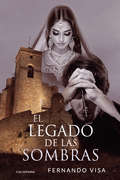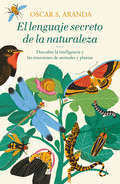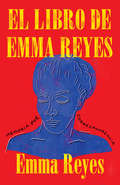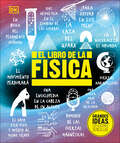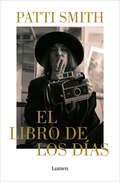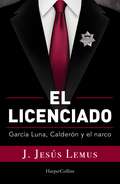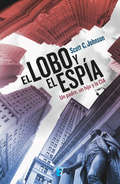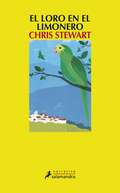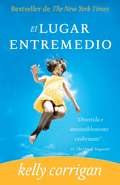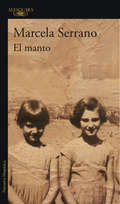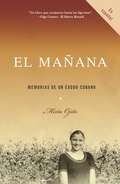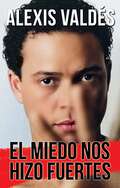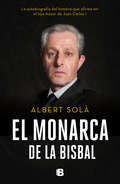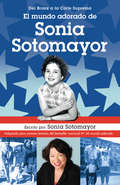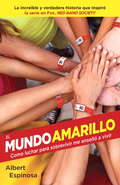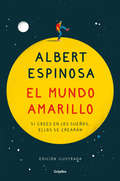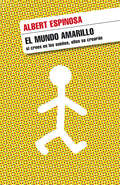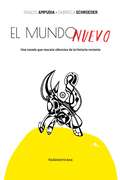- Table View
- List View
El legado de las sombras
by Fernando VisaEl autor de Bastardos de Dios vuelve a reencontrarse con los Capellana, en una continuación incluso más apasionante que la primera parte. Año 1720. El nombre de Isabel de Capellana, incluso habiendo pasado un siglo desde que fuera enviada a la hoguera, aún sigue produciendo escalofríos en los benabarrenses. Despreciados por algunos y temidos por otros, los hijos del último descendiente de la bruja verán cómo su familia se desmorona sin que sus facultades les sirvan para poder evitarlo. Un sacerdote que presiente la muerte, un joven que vendería su alma al diablo por conseguir el amor de una mujer, una bella muchacha que puede leer el pasado y una niña que dibuja lo que nadie puede ver, deberán enfrentarse a un futuro desalentador que los llevará a recorrer medio mundo para encontrar el camino de su propia esencia. ¿Es posible encontrar tu propio destino en el alma de un enemigo?
El lenguaje de las flores
by Vanessa DiffenbaughUna novela inspirada en el sofisticado código que la sociedad victoriana utilizaba para expresar sentimientos por medio de las flores. El viaje emocional de una joven californiana marcada por una dolorosa historia personal que encuentra en este peculiar lenguaje el medio para recuperar su capacidad de confiar y amar a sus semejantes. Una novela recibida con entusiasmo por la crítica y los lectores -en Italia se han vendido más de 400 mil ejemplares-, que se ha publicado en treinta y seis idiomas. A los dieciocho años, tras una vida entrando y saliendo de numerosos hogares de acogida y pisos tutelados, Victoria Jones está obligada a emanciparse por ley. Se ha convertido en una joven introvertida y arisca, y sólo en su pasión por las flores se vislumbra un camino de salvación. Finalmente, tras encontrar trabajo en una floristería, se cruza con un joven aquien conoció diez años antes, durante la época en que vivió en casa de Elizabeth, una madre de acogida que le enseñó el lenguaje de las flores. El misterioso joven conoce un secreto que atormenta a Victoria, aunque sólo ella puede arreglar cuentas con el pasado. Así, Victoria, que es capaz de expresar los sentimientos de los clientes con hermosos ramos, deberá aprender a interpretar sus propias emociones, la única manera de deshacerse del enorme peso que arrastra desde niña y que le impide encontrar la felicidad. La crítica ha dicho...«El lenguaje de las flores es, al mismo tiempo, encantadora y cruel, llena de belleza y de furia. Diffenbaugh es una narradora inteligente e hipnótica.»The Washington Post «No es una historia de amor sencilla, sino una novela de gran riqueza sobre los diferentes amores: la maternidad biológica y la conquistada, la amistad y sus misteriosas formas de comunicación, el apego a la tierra y sus frutos y, finalmente, sobre la relación de pareja, tan difícil de aceptar para una joven mujer que siente aversión por el contacto físico.»Tuttolibri, La Stampa «Una conmovedora primera novela que narra el paso a la edad adulta de un alma profundamente herida, que sólo encuentra consuelo en el olvidado lenguaje de las flores.»Publishers Weekly «Una historia de amor que toca el corazón y abre los ojos a la belleza de las flores.»Frankfurter Neue Presse «La historia de una huérfana que se sobrepone a sus circunstancias como una Jane Eyre de 2011 y [una historia que], fiel a su modelo, es también un atormentado romance.»San Francisco Chronicle «Una historia fabulosa, a la vez mágica y muy cercana a la vida real.»Freundin «Encantadora, honesta y poderosamente absorbente, la primera novela de Diffenbaugh ofrece un incisivo testimonio de los misterios que abriga el corazón humano.»Booklist
El lenguaje secreto de la naturaleza: Descubre la inteligencia y las emociones de animales y plantas
by Oscar S. ArandaUn canto de amor a los animales. Un viaje a lo más profundo de la naturaleza. Todos nos hemos admirado alguna vez ante la grandiosidad y la belleza de la naturaleza. Este libro es un viaje que nos llevará por maravillosos lugares alrededor del mundo para conocer de cerca a seres que, al igual que nosotros, tienen familia, emociones, enfrentan desafíos, toman decisiones y crean alianzas. He dedicado toda mi vida y mi carrera de biólogo al estudio y a la protección de los animales. Espero contagiarte mi admiración por la naturaleza, mi amor por los árboles y mi devoción hacia otros animales que han marcado mi afortunada vida repleta de circunstancias excepcionales, grandes aventuras y encuentros fantásticos con seres sorprendentes. Acompáñame y descubre mi forma de ver el mundo, un lugar donde, sin importar que tengamos el aspecto de un helecho, el carácter de una mosca, la valentía de una hormiga o el corazón de una gaviota, todos somos iguales.
El lenguaje secreto de la naturaleza: Descubre la inteligencia y las emociones de animales y plantas
by Oscar S. ArandaUn canto de amor a los animales. Un viaje a lo más profundo de la naturaleza. Todos nos hemos admirado alguna vez ante la grandiosidad y la belleza de la naturaleza. Este libro es un viaje que nos llevará por maravillosos lugares alrededor del mundo para conocer de cerca a seres que, al igual que nosotros, tienen familia, emociones, enfrentan desafíos, toman decisiones y crean alianzas. He dedicado toda mi vida y mi carrera de biólogo al estudio y a la protección de los animales. Espero contagiarte mi admiración por la naturaleza, mi amor por los árboles y mi devoción hacia otros animales que han marcado mi afortunada vida repleta de circunstancias excepcionales, grandes aventuras y encuentros fantásticos con seres sorprendentes. Acompáñame y descubre mi forma de ver el mundo, un lugar donde, sin importar que tengamos el aspecto de un helecho, el carácter de una mosca, la valentía de una hormiga o el corazón de una gaviota, todos somos iguales. «El lenguaje secreto de la naturaleza nos invita a contemplar nuestro alrededor con una mirada nueva, con una curiosidad con la que, tal vez, no lo habíamos hecho antes.»Blog Anika entre libros.
El libro de Emma Reyes
by Emma Reyes"Asombroso y agriamente poético". --The New York Times Esta sorprendente memoria se convirtió clásico instantáneo cuando se publicó por primera vez en Colombia en 2012, casi una década después de la muerte de su autora, quien fue alentada en sus escritos por Gabriel García Márquez. Mediante veintitrés cartas dirigidas a su amigo y confidente Germán Arciniegas a lo largo de treinta años, Reyes describe de manera viva y con detalles pintorescos el coraje notable y la imaginación ilimitada de una niña que crece con nada. Emma Reyes era una niña ilegítima, criada en una habitación sin ventanas en Bogotá sin agua ni inodoro, y que sobrevivía únicamente de su ingenio para mantenerse a ella misma y a su hermana. Abandonada por su madre, ambas niñas se son acogidas por un convento católico que albergaba a 150 niñas huérfanas, donde lavaban ollas, planchaban y reparaban la ropa, fregaban pisos, limpiaban baños, cosían prendas y telas decorativas para las monjas y vivían contemor al Diablo. Analfabeta y sin saber nada del mundo exterior, Emma escapó a los diecinueve años, estableciendo una carrera como artista y forjando amistades con Frida Kahlo y Diego Rivera, así como con artistas e intelectuales europeos. El retrato de su infancia que surge de este relato clarividente inspira en el lector un asombro especial hacia la deslumbrante vida de una talentosa escritora cuyo talento permaneció oculto por demasiado tiempo.
El libro de Emma Reyes: Memoria por correspondencia
by Emma Reyes"Asombroso y agriamente poético". --The New York TimesEsta sorprendente memoria se convirtió clásico instantáneo cuando se publicó por primera vez en Colombia en 2012, casi una década después de la muerte de su autora, quien fue alentada en sus escritos por Gabriel García Márquez. Mediante veintitrés cartas dirigidas a su amigo y confidente Germán Arciniegas a lo largo de treinta años, Reyes describe de manera viva y con detalles pintorescos el coraje notable y la imaginación ilimitada de una niña que crece con nada.Emma Reyes era una niña ilegítima, criada en una habitación sin ventanas en Bogotá sin agua ni inodoro, y que sobrevivía únicamente de su ingenio para mantenerse a ella misma y a su hermana. Abandonada por su madre, ambas niñas se son acogidas por un convento católico que albergaba a 150 niñas huérfanas, donde lavaban ollas, planchaban y reparaban la ropa, fregaban pisos, limpiaban baños, cosían prendas y telas decorativas para las monjas y vivían con temor al Diablo. Analfabeta y sin saber nada del mundo exterior, Emma escapó a los diecinueve años, estableciendo una carrera como artista y forjando amistades con Frida Kahlo y Diego Rivera, así como con artistas e intelectuales europeos. El retrato de su infancia que surge de este relato clarividente inspira en el lector un asombro especial hacia la deslumbrante vida de una talentosa escritora cuyo talento permaneció oculto por demasiado tiempo.
El libro de la física (DK Big Ideas)
by DKGrandes ideas, explicaciones sencillasCon una prosa sencilla, El libro de la física presenta explicaciones claras y concisas que desbrozan la jerga especializada, diagramas que plasman complejas teorías, citas memorables e ingeniosas ilustraciones que juegan con nuestros conocimientos de la física.¿Cómo generan electricidad los imanes? ¿Qué es la antimateria? ¿Es posible viajar en el tiempo? A partir de estas y otras muchas preguntas, los físicos han ampliado las fronteras del conocimiento humano y nos han ayudado a comprender las leyes físicas que rigen nuestro mundo y el universo.Tanto el estudiante deseoso de aprender como el simple lector curioso acerca del funcionamiento del mundo encontrarán en este libro muchas ideas estimulantes.
El libro de los días
by Patti Smith366 DÍAS EN LA VIDA DE PATTI SMITH, autora de Éramos unos niños y ganadora del National Book Award: una emocionante inmersión en el universo de una mujer única En la lista de más vendidos de The New York Times Uno de los mejores libros del año según varios mediosEn 2018 Patti Smith publicó su primera foto en Instagram: su mano y un simple mensaje: «Hola a todos». Cambió su querida Land Camera 250 por su teléfono y trasladó parte de su diario a la red social, donde comenzó a compartir su día a día con breves reflexiones, desde su café matutino, sus lecturas o su gato abisinio, Cairo, hasta sus viajes o sus visitas a las tumbas de los escritores que más adora. Poco después, más de un millón de personasseguían su cuenta. Inspirándose en ese formato, Patti Smith recoge ahora en El libro de los días trescientas sesenta y seis instantáneas, la mayoría de ellas inéditas, acompañadas de textos que constituyen «esbozos de oráculos»: trescientas sesenta y seis flechas dirigidas al corazón cotidiano de las cosas, trescientas sesenta y seis maneras de decir «hola». Una forma única de sumergirse en el universo íntimo y emocional de una artista que es ya un icono de nuestro tiempo. La crítica ha dicho...«Un fotolibro que funciona como una pieza literaria al abrir ventanas a una vida de búsqueda y exploración».Financial Times «Patti Smith es una diosa intergeneracional».Montserrat Domínguez «El libro de los días parece una exquisita caja de bombones: tiene peso, un aire elegante y clásico y un toque agridulce».Elisabeth Egan, The New York Times«Patti Smith no solo es una gran artista, es una maga, es decir, alguien en contacto con otros niveles de realidad».William S. Burroughs «Su escritura puede moverse desde el recuerdo hasta las observaciones sobre la naturaleza y los instantes difusos entre el sueño y la vigilia. [...] Una corriente eléctrica fluye desde ella y parece decirnos: Sí, eres libre. Puedes coger una guitarra. Puedes escribir lo que quieras. [...] Puedes amar. [...] Eres libre de hacer lo que desees. Su habilidad tanto para vivir de esa manera como para comunicarlo e inspirar a otros es una forma de genialidad».Chloé Cooper Jones, Harper’s Bazaar «Hermosísimo. [...] Un creativo homenaje a escritores, poetas, amigos y familiares».The Observer «Un recordatorio de que podemos encontrar esperanza en los detalles más nimios».Erica Wagner, Harper’s Bazaar«Una obra única y hermosa».Stylist «Tiene Patti Smith una forma de escribir que arropa sin llegar nunca a tocarte. Como un extraño limbo en vida. Como una vuelta al vientre materno en la que hasta el día más oscuro sucede en la más imperturbable paz. [...]Da igual si es una canción, un poema, un dibujo o una fotografía: todo en ella invita a trascender».Eva Blanco Medina, Vogue
El licenciado: García Luna, Calderón y el narco
by J. Jesús LemusEn esta investigación se ahonda en las relaciones que mantuvo durante dos sexenios el encargado de la inteligencia del Estado mexicano y de la seguridad pública del país, y que alcanzaron el grado de fraternidad con los principales capos de las drogas, los que en teoría, eran sus objetivos de captura. Tras una minuciosa revisión documental y testimonial, de expedientes criminales y de actores del narcotráfico, en este trabajo periodístico se expone cómo Genaro García Luna fue el más fuerte aliado del principal jefe del narcotráfico, Joaquín Guzmán Loera, contribuyendo en gran medida al fortalecimiento y crecimiento del Cártel de Sinaloa, una de las organizaciones criminales más poderosas del mundo. La investigación se refuerza con expedientes judiciales, averiguaciones y sentencias, declaraciones de sentenciados, acusados y testigos, así como estudios psicológicos practicados en las cárceles. Aquí se señalan los principales colaboradores de García Luna, y cómo operaron en el entramado criminal y político no solo para permitir la libre operación de los grupos del narcotráfico, sino para maquillar la realidad nacional en una aparente lucha contra la delincuencia, haciendo de la justicia una verdadera farsa mediática, como en los casos de “El Michoacanazo”, “Operación Limpieza”, “La Banda de Los Zodiacos”, “Caso Florence Cassez” y otros episodios vergonzosos de la guerra del narcotráfico en México.
El lobo y el espía: Un padre, un hijo y la CIA
by Scott C. JohnsonScott no sabía que su padre era agente de la CIA, aunque llegó un momento en que fueron inevitables las sospechas. Cuando éstas se confirmaron, el hijo se volvió un cómplice que debía guardar el secreto y al que también le tocaba llevar una doble vida. Estas memorias, que se leen como si fuera una novela de espionaje, nos llevan de Bueva Delhi a Bagdad, pasando por Afganistán, Sarajevo, el campo de entrenamiento de la CIA en Virginia y los demás sitios donde la familia tuvo que instalarse siguiendo al padre y sus emplazamientos. El hijo, con los años, se convirtió en periodista de guerra, sin saber que el trabajo más parecido al de los agentes reclutadores es el periodismo de investigación.
El lobo y el espía: Un padre, un hijo y la CIA
by Scott C. JohnsonUn hilarante retrato del estilo de vida de un agente de la CIA y su hijo, inmersos en tantos secretos que no les queda más que llevar una doble vida. Scott no sabía que su padre era agente de la CIA, aunque llegó un momento en que fueron inevitables las sospechas. Cuando éstas se confirmaron, el hijo se volvió un cómplice que debía guardar el secreto y al que también le tocaba llevar una doble vida. Estas memorias, que se leen como si fuera una novela de espionaje, nos llevan de Nueva Delhi a Bagdad, pasando por Afganistán, Sarajevo, el campo de entrenamiento de la CIA en Virginia y los demás sitios donde la familia tuvo que instalarse siguiendo al padre y sus emplazamientos. El hijo, con los años, se convirtió en periodista de guerra, sin saber que el trabajo más parecido al de los agentes reclutadores es el periodismo de investigación. Estás páginas nos permiten asomarnos a la vida privada de un espía, explorar una compleja relación padre e hijo, mirar desde las trincheras los conflictos que el autor ha cubierto o conocer datos reveladores sobre la presencia de la CIA en México en los días previos a la matanza de Tlatelolco.
El loro en el limonero
by Chris StewartSegunda parte de la trilogía sobre el encanto de la vida alternativa que vive Chris Stewart en la Alpujarra granadina. Con el formidable éxito de ventas de Entre limones -el divertidísimo relato autobiográfico de un joven inglés que, con tal de no vestir traje y acudir a una oficina, se gasta todos sus ahorros en la compra de un ruinoso cortijo en la Alpujarra granadina- Chris Stewart dio comienzo a su célebre trilogía sobre el irresistible encanto de la vida alternativa, en la que los pequeños sucesos cotidianos y la tranquila observación del espectáculo que supone la actitud del hombre ante sus semejantes y ante la naturaleza compensan con creces los placeres materiales de una vida normal. Acompañado por su mujer Ana, la pequeña Chloé y un loro algo misántropo que forma parte del núcleo familiar, Chris relata con su inimitable estilo las nuevas experiencias que le depara su retiro voluntario del mundanal ruido. Su relación con los vecinos, los entresijos de la escolarización en España, el descubrimiento de un plan para construir una presa que dejaría buena parte del valle sepultada bajo el agua, todo es motivo de asombro. Y por añadidura, el éxito de su primer libro atrae a un hatajo de periodistas ingleses interesados en su vida anterior a su llegada a las Alpujarras: las temporadas pasadas en Suecia esquilando ovejas en mitad del invierno, su primer contacto con España para aprender a tocar la guitarra flamenca, su trabajo en un circo y su breve carrera musical como batería del grupo de rock de su colegio: Genesis. La crítica ha dicho...«Stewart tiene un talento especial para captar los diálogos, una curiosidad insaciable, un optimismo contagioso y un plácido sentido del humor a prueba de conspiraciones xenófobas: Beatus ille.»Babelia «Cuando un autor es tan divertido y modesto como Stewart, uno no se cansa de leer su historia.»The Times «Stewart nunca es condescendiente, se limita a observar [...] divertido, generoso y amable.»The Guardian «Stewart nunca pierde el olfato para detectar las buenas anécdotas.»The Telegraph
El lugar entremedio: The Middle Place
by Kelly CorriganEl lugar entremedio es una historia de crecimiento personal, una crónica del cáncer y un homenaje a un padre excepcional. Es el sobrecogedor relato de una mujer que se enfrenta a múltiples desafíos y de su capacidad de sobreponerse a la adversidad. Kelly Corrigan es una feliz mujer casada, madre dos preciosas hijas, que tienes una columna semanal en un periódico de San Francisco. Su modelo a seguir es su padre, el carismático y encantado George Corrigan , quien reciba cada mañana con su característico "HOLA MUNDO" y siempre se las arregla para encontrar el lado positivo de todo. A sus más de treinta años, Kelly se encuentra en lo que ella llama el "lugar entremedio" ese momento en que se es madre e hija a la vez. Pero todo cambia de repente, cuando Kelly encuentra un bulto en su pecho. Y por si fuera poco, su padre --su héroe-- también tiene cáncer y ahora será el turno de Kelly de cuidar del hombre que siempre estuvo ahí para ella.From the Trade Paperback edition.
El lugar entremedio: The Middle Place
by Kelly CorriganEl lugar entremedio es una historia de crecimiento personal, una crónica del cáncer y un homenaje a un padre excepcional. Es el sobrecogedor relato de una mujer que se enfrenta a múltiples desafíos y de su capacidad de sobreponerse a la adversidad. Kelly Corrigan es una feliz mujer casada, madre dos preciosas hijas, que tienes una columna semanal en un periódico de San Francisco. Su modelo a seguir es su padre, el carismático y encantado George Corrigan , quien reciba cada mañana con su característico HOLA MUNDO y siempre se las arregla para encontrar el lado positivo de todo. A sus más de treinta años, Kelly se encuentra en lo que ella llama el lugar entremedio ese momento en que se es madre e hija a la vez. Pero todo cambia de repente, cuando Kelly encuentra un bulto en su pecho. Y por si fuera poco, su padre su héroe también tiene cáncer y ahora será el turno de Kelly de cuidar del hombre que siempre estuvo ahí para ella.
El manto
by Marcela SerranoUna conmovedora reflexión sobre la pérdida. El libro más personal de Marcela Serrano En noviembre de 2017, tras años de ir y venir, un cáncer terminó con la vida de la periodista Margarita Serrano. Devastada, su hermana Marcela encontró en el retiro campesino y en la escritura la única manera de sobrellevar el desconcierto, la tristeza y la rabia. Ese estado de excepción emocional es lo que está en la base de estas páginas que, con el pasar de los días, la autora fue tejiendo como un manto para cubrir a su hermana y a quienes tras su muerte quedaron a la intemperie. El resultado de ese arrojo son los emocionantes, tristes y a la vez luminosos apuntes # discontinuos como el duelo mismo# que Serrano reunió con lucidez y coraje durante todo el año que siguió a la muerte de #la M#. Cita: Tiene el ideario y el corazón amueblados con una firmeza que es capaz de esquivar todas las contradicciones." Ángela López, El Mundo
El mañana
by Mirta OjitoEn esta memoria sobre una niña, dos culturas y una lucha por la libertad, la periodista Mirta Ojito, ganadora del Premio Pulitzer, vuelve al evento en su adolescencia que cambió su vida para siempre: el éxodo en el 1980 de más de 125.000 cubanos, mejor conocido como el puente marítimo del Mariel. Con perseverancia y mucho corazón, Ojito logra localizar en Cuba y Estados Unidos a los individuos –ya olvidados por la historia– cuyas acciones desencadenaron los sucesos que impactaron su vida y la de otros miles de cubanos a ambos lados del Estrecho de la Florida. Su libro es un relato conmovedor de cómo una niña creció desgarrada entre las críticas contra el gobierno que reinaban en su casa y el arrastre de una revolución que exigía lealtad absoluta. El Mañana ofrece una mirada inolvidable dentro del corazón de una valiente refugiada adolescente.
El mañana
by Mirta OjitoEn esta memoria sobre una niña, dos culturas y una lucha por la libertad, la periodista Mirta Ojito, ganadora del Premio Pulitzer, vuelve al evento en su adolescencia que cambió su vida para siempre: el éxodo en el 1980 de más de 125.000 cubanos, mejor conocido como el puente marítimo del Mariel. Con perseverancia y mucho corazón, Ojito logra localizar en Cuba y Estados Unidos a los individuos ya olvidados por la historia cuyas acciones desencadenaron los sucesos que impactaron su vida y la de otros miles de cubanos a ambos lados del Estrecho de la Florida. Su libro es un relato conmovedor de cómo una niña creció desgarrada entre las críticas contra el gobierno que reinaban en su casa y el arrastre de una revolución que exigía lealtad absoluta. El Mañana ofrece una mirada inolvidable dentro del corazón de una valiente refugiada adolescente.
El miedo nos hizo fuertes
by Alexis ValdésLa conmovedora historia de un niño que, a pesar de afrontar el abuso físico en casa, en su barrio y en su país, jamás perdió la alegría de vivir. Alexis Valdés escribe con profunda ternura sobre el niño que fue y logra reflejar en estaspáginas no solo los años más duros de su vida, sino transportar al lector a la Cuba de su infancia y adolescencia, con sus problemas, sus carencias, su dolor, pero también con una alegría de vivir y la esperanza de que algún día todo será mejor. El pequeño Alexis es un niño sensible y tímido, que vive con su madre, su hermano y su padrastro que le odia porque se parece mucho a su padre. El machista padrastro no soporta esa imagen dentro de la casa: La imagen del otro hombre de su mujer. El autor narra su vida en un país donde el abuso y el bullying flota en el ambiente: En casa,donde soportaba las palizasdel innombrable, porque se rehusa a escribir su nombre; en el barrio, donde otros padres golpean a sus hijos, los fuertes abusan de los débiles y los homosexuales son masacrados, y en el país donde el gobierno abusa de todos. Alexis y su familia viven en un barrio de La Habana donde los guapos —los tipos duros dela calle— imponen su ley. Es un ambiente salvaje donde son comunes las peleas de boxeo clandestinas. Solo hay un hombre bueno al que todos temen en el barrio, fuerte como una roca, el padrastro de Renecito, el niño estrella del barrio, y uno de los defensores denuestro protagonista. Los otros defensores que salvan al niño son su abuela América, una viejita mágica que leda esperanza y fuerza; su hermano asmático y delgaducho, pero muy valiente, y su padre,que es un hombre de éxito, alegre y cariñoso, pero al que no permiten ver a menudo. El escape del niño es su sueño de viajar a Praga, una ciudad llena de castillos y niños con gorritos y las mejillas rosadas. Todo comienza cuando participa en un concurso de Radio Praga Internacional, que tiene una emisión especial para América Latina. El niño les manda una carta cada semana para participar en el concurso que, de ganarlo, le llevaría ala hermosa ciudad Checa, y más que eso, le sacaría por un tiempo del infierno en que vive.
El monarca de La Bisbal: La autobiografía del hombre que afirma ser el hijo mayor de Juan Carlos I
by Albert SolàLa autobiografía del hombre que afirma ser el hijo mayor de Juan Carlos I. Albert Solà es conocido como «el monarca» en el municipio donde vive: La Bisbal del Ampurdán. Sin embargo, aunque su parecido con Juan Carlos I salta a la vista, sus orígenes están llenos de misterio e incertidumbres. En este libro, Albert narra su vida y las razones que le llevan a afirmar que es el hijo primogénito (e ilegítimo) del rey emérito de España, nacido de una aventura con una joven de la alta burguesía catalana. Durante su infancia y adolescencia, Albert Solà siempre tuvo la sensación de que le observaban; incluso hizo la mili convencido de que le daban un trato especial. Más adelante, cuando empezó a investigar sus orígenes y quiso reclamar documentos sobre su nacimiento y adopción, halló todo tipo de trabas, pero también encontró a muchas personas -desde gente anónima hasta detectives y agentes del Centro Nacional de Inteligencia- que leaseguraron que es hijo del rey emérito Juan Carlos I. El monarca de La Bisbal ofrece, por primera vez, el relato completo y en primera persona de una historia única y fascinante que ha atraído a medios de comunicación de la talla del New York Times. El resultado llega dispuesto a sembrar la polémica.
El mundo adorado de Sonia Sotomayor
by Sonia SotomayorEn esta adaptación para alumnos de grados intermedios, basada en su exitosa memoria para adultos Mi Mundo Adorado, la vida extraordinaria de Sonia Sotomayor, Jueza Asociada de la Corte Suprema, es una inspiración. Su logro sirve como un verdadero testimonio al hecho de que sin importar los obstáculos, los sueños siempre pueden hacerse realidad. Incluye una inserción de fotos de 8 páginas.Sonia Sotomayor, la primera mujer hispana y tercera mujer nombrada para el Tribunal Supremo de los Estados Unidos, era una niña cuando se atrevió a soñar en grande. ¿Su sueño? Convertirse en un abogado y un juez. Como explica la juez Sotomayor: "Cuando era niña, mi familia era pobre y no conocíamos abogados ni jueces, y ninguno vivía en nuestro vecindario. No sabía nada sobre el Tribunal Supremo ni de como su reinterpretación de la Constitución y las leyes del país afectan a las vidas de las personas estadounidenses. No puedes soñar con ser algo que ni siquiera conoces. Esa ha sido la lección más importante de mi vida. Tienes que aprender a soñar grandes sueños". Sonia no dejó que las dificultades de su pasado --entre ellas el crecer en las rudas viviendas gubernamentales del sur del Bronx en Nueva York, el lidiar con la diabetes juvenil, el soportar las graves discusiones de sus padres y el preocuparse por el dinero-- se impusieran en su camino. Siempre creía en sí misma, y su determinación, junto con la orientación de generosos mentores y el amor inquebrantable de su extendida familia puertorriqueña, la impulsaron a seguir adelante.
El mundo adorado de Sonia Sotomayor
by Sonia SotomayorEn esta adaptación para alumnos de grados intermedios, basada en su exitosa memoria para adultos Mi Mundo Adorado, la vida extraordinaria de Sonia Sotomayor, Jueza Asociada de la Corte Suprema, es una inspiración. Su logro sirve como un verdadero testimonio al hecho de que sin importar los obstáculos, los sueños siempre pueden hacerse realidad. Incluye una inserción de fotos de 8 páginas. Sonia Sotomayor, la primera mujer hispana y tercera mujer nombrada para el Tribunal Supremo de los Estados Unidos, era una niña cuando se atrevió a soñar en grande. ¿Su sueño? Convertirse en un abogado y un juez. Como explica la juez Sotomayor: "Cuando era niña, mi familia era pobre y no conocíamos abogados ni jueces, y ninguno vivía en nuestro vecindario. No sabía nada sobre el Tribunal Supremo ni de como su reinterpretación de la Constitución y las leyes del país afectan a las vidas de las personas estadounidenses. No puedes soñar con ser algo que ni siquiera conoces. Esa ha sido la lección más importante de mi vida. Tienes que aprender a soñar grandes sueños". Sonia no dejó que las dificultades de su pasado --entre ellas el crecer en las rudas viviendas gubernamentales del sur del Bronx en Nueva York, el lidiar con la diabetes juvenil, el soportar las graves discusiones de sus padres y el preocuparse por el dinero-- se impusieran en su camino. Siempre creía en sí misma, y su determinación, junto con la orientación de generosos mentores y el amor inquebrantable de su extendida familia puertorriqueña, la impulsaron a seguir adelante.
El mundo amarillo (Movie Tie-in Edition)
by Albert EspinosaLa increíble y verdadera historia que inspiró la serie de Steven Spielberg en FOX, Red Band SocietyMis héroes no usan capas rojas. Usan pulseras rojas. Descubre la sensacional autobiografía que ha conmovido e inspirado a los lectores de todo el mundo. Albert Espinosa nunca quiso escribir un libro acerca del cáncer, y no lo hizo. En cambio, aquí comparte sus recuerdos más graciosos, trágicos y felices con la esperanza de que de ellos otros muchos, sanos o enfermos, saquen fuerza y vitalidad. A los trece años, a Espinosa le diagnosticaron cáncer y pasó los siguientes diez años en hospitales, sometiéndose a desalentadores procedimientos, incluyendo la amputación de su pierna izquierda. Solo tras haber perdido un pulmón y la mitad del hígado, lo declararon libre del cáncer. Y solo entonces se dio cuenta de que lo único más triste que morir es no saber cómo vivir. En esta obra, Espinosa nos lleva a lo que él llama "el mundo amarillo", un lugar donde el miedo pierde su significado; un lugar lleno de desconocidos quienes, por tan solo un momento, se vuelven tus mejores aliados; y un lugar donde las lecciones que aprendes te nutrirán el resto de tu vida.
El mundo amarillo (edición ilustrada): Si crees en los sueños, ellos se crearán
by Albert EspinosaEDICIÓN ILUSTRADA POR PEP BOATELLA Si crees en los sueños, ellos se crearán. El creer y el crear están a una letra de distancia. El mundo amarillo es un mundo fantástico que quiero compartir contigo en esta edición ilustrada para celebrar la traducción a 30 idiomas y los más de 2.500.000 de ejemplares vendidos. En El mundo amarillo encontrarás los descubrimientos que hice durante los diez años que estuve enfermo de cáncer. Es curioso, pero la fuerza, la vitalidad y los hallazgos que haces cuando estás enfermo sirven también para cuando estás bien. Con este libro deseo que conozcas este mundo especial y diferente, pero sobre todo, quiero que descubras a los «amarillos». Ellos son el nuevo escalafón de la amistad, esas personas que no son amantes ni amigos, esa gente que se cruza en tu vida y que, tras una sola conversación, puede llegar a cambiarla. No te adelanto más: tendrás que leer el libro para poder a encontrar tus «amarillos». Quizá yo sea uno de ellos... ¿Quieres saber quiénes son tus «amarillos»?Albert Espinosa
El mundo amarillo: Si crees en los sueños, ellos se crearán (Vintage Espanol Ser.)
by Albert EspinosaLos «amarillos» esas personas que se sitúan entre el amor y la amistad, esas personas que dan sentido a nuestra vida. «El mundo amarillo es un mundo fantástico que quiero compartir contigo. Es el mundo de los descubrimientos que hice durante los diez años que estuve enfermo de cáncer. Es curioso, pero la fuerza, la vitalidad y los hallazgos que haces cuando estás enfermo sirven también cuando estás bien, en el día a día. »Este libro pretende que conozcas y entres en este mundo especial y diferente; pero, sobre todo, que descubras a los "amarillos". Ellos son el nuevo escalafón de la amistad, esas personas que no son ni amantes ni amigos, esa gente que se cruza en tu vida y que con una sola conversación puede llegar a cambiártela. No te adelanto más: tendrás que leer este libro para poder empezar a encontrar tus "amarillos". Quizás uno de ellos sea yo... »El mundo amarillo habla de lo sencillo que es creeren los sueños para que estos se creen. Y es que el creer y el crear están tan sólo a una letra de distancia. »¿Qué esperas a saber quiénes son tus "amarillos"?»Albert Espinosa Reseña:«Albert habla de un mundo al alcance de todos, y que tiene el color del Sol: el mundo amarillo. Un sitio cálido donde los besos pueden durar diez minutos, donde los desconocidos pueden ser tus mejores aliados, donde el miedo pierde su significado, donde la muerte no es eso que les pasa sólo a los demás y la vida es lo más valioso. Este libro habla de todo esto, de todo lo que sentimos y no decimos, del miedo a que nos quiten lo que tenemos, de reconocernos enteramente y apreciar quiénes somos cada segundo del día. ¡Larga vida a Albert!»Eloy Azorín, actor
El mundo nuevo: Una novela que rescata silencios de la historia reciente
by Gabriela Schroeder Ignacio Ampudia¿Cuánto dolor puede soportar un cuerpo? ¿Dónde está el límite de la transformación necesaria para sobrevivir? ¿Qué huellas dejaron las viejas luchas en la memoria de las nuevas generaciones? Este es un relato sobre personajes dispuestos a dar sus vidas para construir un mundo más justo. Personajes que dialogan cara a cara con el terror; que caen, cuestionan sus propios mitos, resurgen y vuelven a caer. Un grupo de jóvenes que se entrega a la revolución; una madre que migra de la mano de su hija, esquivando peligros; tres países que se precipitan hacia los períodos más oscuros de su historia; un abuelo que em-prende una búsqueda incesante para recuperar a su nieta. El mundo nuevo entreteje episodios fundamentales de la historia reciente de Uruguay, Chile y Argentina, y transita por territorios poco explorados, como el rol de las mujeres en las guerrillas y la utilización de los niños como herramienta de tortura durante las dictaduras. En una búsqueda por rescatar sus orígenes, Gabriela Schroeder Barredo comparte su historia familiar de amor, dolor y pérdida, a través de una novela basada en decenas de testimonios, investigación documental y la narrativa del historiador Ignacio Ampudia. El resultado es un texto vertiginoso que cuestiona, conmueve y busca iluminar silencios implacables.
